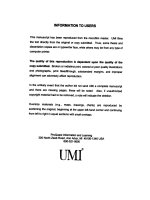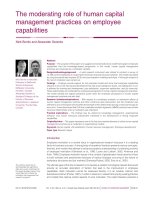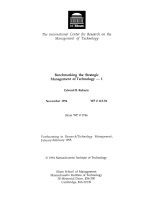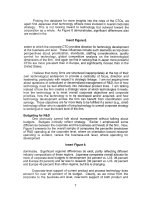Strategic management of human capital
Bạn đang xem bản rút gọn của tài liệu. Xem và tải ngay bản đầy đủ của tài liệu tại đây (3.73 MB, 171 trang )
VENKATESH GANAPATHY
STRATEGIC
MANAGEMENT OF
HUMAN CAPITAL
Download free eBooks at bookboon.com
2
Strategic Management of Human Capital
1st edition
© 2018 Venkatesh Ganapathy & bookboon.com
ISBN 978-87-403-2036-7
Peer review by Ganapathy Dharmarajan, Director, Vega Cylinders, Mumbai
Download free eBooks at bookboon.com
3
STRATEGIC MANAGEMENT
OF HUMAN CAPITAL
CONTENTS
CONTENTS
Acknowledgements
7
1
What is human capital management
8
2
Scope of human capital management
12
3
Need for human capital management
16
4
Benefits of a HCM approach
18
5
Knowledge management and human capital management
19
6
Differences between HRM and HCM
25
7
The HCM versus HRM dilemma
26
8
HR in small organizations
28
9
Trends in human capital management
31
10
Strategic management of human capital
34
www.sylvania.com
We do not reinvent
the wheel we reinvent
light.
Fascinating lighting offers an ininite spectrum of
possibilities: Innovative technologies and new
markets provide both opportunities and challenges.
An environment in which your expertise is in high
demand. Enjoy the supportive working atmosphere
within our global group and beneit from international
career paths. Implement sustainable ideas in close
cooperation with other specialists and contribute to
inluencing our future. Come and join us in reinventing
light every day.
Light is OSRAM
Download free eBooks at bookboon.com
4
4
Click on the ad to read more
STRATEGIC MANAGEMENT
OF HUMAN CAPITAL
CONTENTS
11
Managing human capital in today’s economy
42
12
Leadership traits in the 21st century
49
13
The true test of leadership
51
14
Can leadership be taught or learned?
53
15
Abusive leadership
55
16
Leadership and change management
58
17
It can be lonely at the top
60
18
Level 5 leadership
63
19
Tipping point leadership
68
20
Servant leadership
71
21
Micromanagement kills
74
22
The power of delegation
76
23
Introduction to recruitment & selection
78
24
Induction program
80
25
Innovative hiring in retail
82
26
Smart hiring in start-ups
84
27
Emotional intelligence revisited
86
28
Placement agencies
89
29
Bespoke headhunting
91
30
Reference checking: an effective tool for HR managers
97
31
Dipping morale in organizations
99
32
Does 360 degree feed back always work?
101
33
Gen Y: Is Maslow’s theory still valid?
106
34
Compensation management & pay parity
108
35
A good boss, handsome salary or career growth
110
Download free eBooks at bookboon.com
5
STRATEGIC MANAGEMENT
OF HUMAN CAPITAL
CONTENTS
36
Dealing with frenemies in the work place
113
37
Impression management in organizations
117
38
Tale carriers
118
39
Five tips: should you quit your job?
121
40
Writing a winning resume
123
41
Appearing for an interview?
129
42
The merits of career planning
132
43
Talent management
136
44
Differences between HCM and talent management
142
45
Redefining talent management
144
46
Curry leaves, banana & talent
147
47
Job enrichment & job enlargement
149
48
Job-related stress
150
49
Reverse mentoring
153
50
The involved employee – how to spot one!
160
51
Dealing with Gen Y
162
52
The need to retain seasoned professionals
164
53
When talent becomes a liability…
166
References
168
Download free eBooks at bookboon.com
6
STRATEGIC MANAGEMENT
OF HUMAN CAPITAL
ACKNOWLEDGEMENTS
ACKNOWLEDGEMENTS
his book is a result of my eforts spread over the last two years. A lot of people contributed
in no small measure to ensure that the book was completed on time. I must admit that
my family has been a great support as most of my personal time was invested in this
endeavor. hough I am not a HR practitioner, the seeds of my interest in HR were sown
just by observing my father Mr. D Ganapathy who has been a HR practitioner for more
than 50 years now. He has worked for organizations like Colgate Palmolive India Limited,
Associated Cements Corporation and DCW Limited. He is also a renowned head hunter
and an Industrial relations expert. his book is primarily dedicated to him.
I am indebted to Dr AL Ravimohan, my irst boss in Castrol India Limited. I recall with
fondness and gratitude how he made me feel comfortable when I joined Castrol as a management
trainee in 1992. He infused in me a passion and liking for research and encouraged me at
every step. I am also indebted to Mr Allen Sequeira, former Vice-President (HR), Castrol India
Limited and Mr RV Anand, Director-HR-Castrol India Limited. hey made the recruitment
and selection processes appear like a breeze. Today’s recruiters can learn a lot from them.
I must thank Dr Brahm Sharma, Dr MJ Arul and Dr Radha Padmanabhan for helping me
learn the various facets of leadership in academic institutions. Dr Radha, present Director
of our management institution has a very unique leadership style that is inspiring and
invigorating. Her leadership always brims with positivity and cheer. Her dedication and
commitment to her profession are truly exemplary and worth emulating.
I would also like to thank three of my dear colleagues who, though junior to me in age,
are leap years ahead of me in terms of their academic experience, wit and wisdom. I would
like to thank Dr Irshad Nazeer for suggesting the title of this book. hanks are also due to
Dr R Venkatraman, Dean-Presidency Business School for always encouraging and motivating
me. His people-centric leadership style and cherubic demeanor can convert the most dull,
morbid and insipid environment into a lively one. hanks Dr Chandan Chavadi for teaching
me some of the virtues in life. hanks for helping me reconnect with research after so many
years. Your willingness to lead, help others and taking initiatives to enrich the institution’s
intellectual capacity deserve commendation of the highest order. I am yet to see someone
who is as passionate about research as Dr Chandan.
hanks are also due to Karin and her editorial team for the excellent support that they provided.
Last but not the least I would like to express my heartfelt thanks to Dr Nissar Ahmed,
Chairman, Presidency Group of Institutions, India. His encouragement and support have
always enabled me to raise the bar of excellence from time to time.
Download free eBooks at bookboon.com
7
STRATEGIC MANAGEMENT
OF HUMAN CAPITAL
1
WHAT IS HUMAN CAPITAL MANAGEMENT
WHAT IS HUMAN CAPITAL
MANAGEMENT
Learning objectives:
1. To understand the concept of human capital management.
2. To identify the need for a human capital strategy.
3. To learn about the diferent types of human capital.
Business environment is highly turbulent today. Organizations build their own core resources
to achieve competitive edge. But this can be transitory. Employee’s individual and collective
learning, knowledge, skills and expertise, creativity and innovation lead to accumulation of
human capital. Accumulation of individual and collective knowledge is essential to meet
customer needs. Human capital is thus a key intangible form of value creation.
Human capital represents competences of employees, knowledge, skills, experiences and
abilities of employees. Human capital is a part of intellectual capital and represents intangible
sources of irms.
Human capital is deined as the individual’s knowledge, experiences, capabilities, skills,
creativity and innovativeness. hese elements are connected to each other and collectively
contribute to success in work. Advocates of human capital approach assert that many of the
assets that individuals bring to the organization are intangible, premised in the individual
tacit knowledge rather than more explicit, formal, routine and standardized knowledge
(Fida Aiouni, 2009).
Human capital pool is highly skilled and motivated work force that has greater potential to
be a source of competitive advantage. Human capital pool must have both high levels of skill
and willingness to exhibit productive behavior. he advantage of human capital is that it is
a stock of exceptional human talent with latent productive capabilities (Fida Aiouni, 2009).
Human capital management leads to good management of people. Well-developed HR
practices & favorable learning environment encourage people to deploy their skills leading
to competitive advantage. Human capital pool must individually and collectively choose to
engage in behavior that beneits the irm (Fida Aiouni, 2009).
Coherent results oriented human capital program is essential. Human capital management is
not about top down decision making as it can cause adversarial relations between management
Download free eBooks at bookboon.com
8
STRATEGIC MANAGEMENT
OF HUMAN CAPITAL
WHAT IS HUMAN CAPITAL MANAGEMENT
and employees. Not reacting to workplace disputes or inability to resolve long standing
sources of conlict can be dampeners.
Human capital management is about embracing an innovative approach and recognizes
the value of employee inputs. Feedback must be encouraged to improve the workplace
environment, communication, identiication of shared interests and creation of shared value.
It is essential to build a diverse workforce and zero tolerance to discrimination. Managers
have the authority to accomplish goals through problem solving approaches. Communication
lows up and down the organization.
Collaborative work will ensure minimum conlicts. Even if there are conlicts they need
to be addressed fairly and eiciently. An inclusive workforce is a competitive advantage
for achieving results. he work culture has to be results oriented, externally focused and
individual performance must be fully integrated into the organization’s goals.
Performance management and rewards system are important for achieving strategic goals
and objectives. Clearly deined, transparent and consistently communicated performance
expectations addressing a range of results go a long way in ensuring success of a human
capital management program.
Formal human capital planning is important. here is a need for sustained commitment to
strategically manage human capital and support eforts to integrate human capital approaches
with our organizational goals. Reining HCM goals with respect to changing organizational
needs and the demonstrated successes of human capital eforts will lead to true success.
For employees to be empowered, they need to be engaged. Optimum alignment between
workforce and mission is essential. he human capital management strategy has to be
integrated into strategic plans, performance plans and budgets.
Unstable markets and intensity of competition has necessitated improvement in capabilities,
eicient processes and innovation. Knowledge is a quintessential resource. It is learned,
created, owned, shared and used by people individually and collectively for wealth creation
by an organization. Success of an organization depends on continuous enrichment of its
human capital. If people are treated as assets, then learning, development, sharing and
creative use of knowledge will supplement such an organizational initiative.
If resources are not upgraded and developed on a regular basis then they decline/diminish.
Business capacity to produce extra customer will lead to instant learning and increasing
application of knowledge to work by its people. Employees should learn and know about
company’s competitive business environment and this will lead to productive behaviors.
Download free eBooks at bookboon.com
9
STRATEGIC MANAGEMENT
OF HUMAN CAPITAL
WHAT IS HUMAN CAPITAL MANAGEMENT
Importance of human capital depends on the degree to which it contributes to creation of
competitive diferentiation. As uniqueness of human capital increases, irms have incentives to
invest resources into its management to reduce risks and capitalize on its productive potential.
here are 4 types of human capital
1.
2.
3.
4.
Idiosyncratic.
Ancillary.
Core.
Compulsory.
Idiosyncratic Human Capital
Low value, highly unique
his type of capital links with relational and organizational capital to increase performance of
this form of human capital through collaboration, team building and group based rewards.
Ancillary
Low value, Low uniqueness
Employee knowledge may not be relevant to customer. Disinvestment in such employees
may be needed. Unskilled labor can be replaced with technology/automation.
Core
High value, high uniqueness
Companies should develop and maximize its value creating potential and diferentiating
characteristics. Commitment based HR systems and developmental performance appraisals
to build speciic knowledge and competitiveness.
Download free eBooks at bookboon.com
10
STRATEGIC MANAGEMENT
OF HUMAN CAPITAL
WHAT IS HUMAN CAPITAL MANAGEMENT
Compulsory Human Capital
High value, low uniqueness
Organizations do not invest in human capital. his capital is not speciic to any one company.
Employees are free within certain limits to sell their talents wherever they can achieve the
higher return. Organizations can organize the staing process such that potential employees
can be identiied to increase productivity.
Focus of human capital has to be sharper, broader and deeper to develop, retain and sustain
competitiveness of enterprise. Focus of HR has to be on developing employee’s working skills.
Human capital has to develop employee’s capabilities and help employees learn from mistakes.
Even high level of HRM and development practices lead to serious strategic and cognitive
failures by missing the focus of human capital. Ford, General Motors and Chrysler failed
to see the increasing threat of Japanese competition. What Sears failed to do, Walmart did
and tasted phenomenal success. IBM was late in entering the PC market.
Apple capitalized on Xerox’s R&D. Xerox missed out on the PC revolution. Compaq missed
the opportunity of JIT assembly of PCs as a result it was done by Dell with outstanding
success. People are the ultimate resource of an organization. herefore, the ability of
enterprises to compete in highly competitive markets, creation of value added products and
services depend on employee’s accumulation of knowledge and capabilities – this depends
on efectiveness of human capital.
Download free eBooks at bookboon.com
11
STRATEGIC MANAGEMENT
OF HUMAN CAPITAL
2
SCOPE OF HUMAN CAPITAL MANAGEMENT
SCOPE OF HUMAN CAPITAL
MANAGEMENT
Learning objectives:
• To understand the scope of human capital management.
• To learn about the essentials of strategic human capital management.
• To identify the challenges associated with human capital management.
Capable, motivated and high performing employees contribute immensely to an organization’s
success and sustained level of organizational performance. Capital is used to generate wealth
for an organization. Employees as resources can generate more wealth. Human capital
represents collective skills and knowledge of total work force of an organization. Human
capital management creates value by proper utilization of people’s potential (Rainke, 2015).
Knowledge, skills, attributes and brainpower that an employee possesses are viewed as the
organization’s human capital. he collective composition of an organization’s human capital
is considered a key strategic business advantage. Human capital deines and categorizes a
person’s embodied knowledge, health, skills and abilities as they afect production, exchange
and entrepreneurship as well as disembodied human knowledge as relected in publications,
patents and other forms of intellectual capital that contribute to the formation and transfer
of new knowledge and innovation (Rainke, 2015).
Business strategy should also be shaped at times by people management strategy rather
than solely the other way round. Employee value proposition refers to what an individual
employee can expect to receive in return for his/her contribution (Rainke, 2015).
People are an agency’s most important organizational asset. An organization’s people deine its
character, afect its capacity to perform and represent the knowledge base of the organization.
Efective strategic human capital management approaches serve as the cornerstone of any
serious change management initiative. herefore organizations must become less hierarchical,
process oriented, stove piped and inwardly focused (Walker, 2002). he more lat an
organization is, it can become results oriented, integrated and externally focused. Shortfalls
in human capital will erode ability of an organization.
Lack of a consistent strategic approach to marshaling, managing and maintaining human
capital can have adverse consequences for the business. So, a strategic approach can ensure
maximization of performance and its accountability.
Download free eBooks at bookboon.com
12
STRATEGIC MANAGEMENT
OF HUMAN CAPITAL
SCOPE OF HUMAN CAPITAL MANAGEMENT
he major challenges in human capital management are:
•
•
•
•
•
Leadership, continuity and succession planning.
Strategic human capital planning and organizational alignment.
Acquiring and developing staf whose size, skills and deployment meet agency needs.
Creating results-oriented organizational cultures.
Sustained eforts needed to increase performance and increase in accountability.
he critical success factors for managing human capital are interrelated and mutually
reinforcing. Compartmentalization of human capital issues is not advisable. hese issues
cannot be dealt with in isolation from one another.
360°
thinking
.
Discover the truth at www.deloitte.ca/careers
Download free eBooks at bookboon.com
13
13
© Deloitte & Touche LLP and affiliated entities.
Click on the ad to read more
STRATEGIC MANAGEMENT
OF HUMAN CAPITAL
SCOPE OF HUMAN CAPITAL MANAGEMENT
Leadership
Commitment to HCM
Role of HC function
Strategic HC planning
Integration & alignment
Data driven decisions
Acquiring and developing
and retaining talent
Targeted investments
in people
Human capital approaches
tailored to meet
organizational needs
Results oriented
organizational cultures
Empowerment and
inclusiveness
Unit and individual
performance linked to
organizational goals
Two principles that are central to the human capital idea are:
1. People are assets whose value can be enhanced through investment. he goal is to
maximize value while managing risk and incompetence. Training is essential.
2. An organization’s human capital approaches should be designed, implemented and
assessed by the standard of how well they enable the organization to achieve results
and pursue its mission.
Essentials of strategic human capital management
1. Approach to human capital must be compliance based. Company should understand
the value of managing the human capital strategically to achieve results. Existing
human capital approaches have to be assessed in light of current and emerging needs.
2. People are critical assets who have to be managed strategically. New human capital
policies, programs and practices are being designed and implemented to support
accomplishment of mission.
3. Improved human capital management leads to improved organizational performance.
Human capital considerations need to be fully integrated into strategic planning
and day to day operations. Managing people well is crucial for achieving results.
4. Maximization of value of human capital is not about speciic actions but bringing
about a cultural transformation.
5. Top leaders must demonstrate commitment to change. Better ways of doing business
must be explored. Investment in human capital must be considered important to
drive continuous improvement, direct reforms and drive cultural change. Fostering
a major change in culture will need skills, capabilities and commitment.
6. Leadership must marshal the resources needed to drive change and overcome
resistance by employees to change. Organization wide commitment is needed to
improve ways of doing business. Conducive conditions have to be created for
efectively improving human capital approaches.
Download free eBooks at bookboon.com
14









